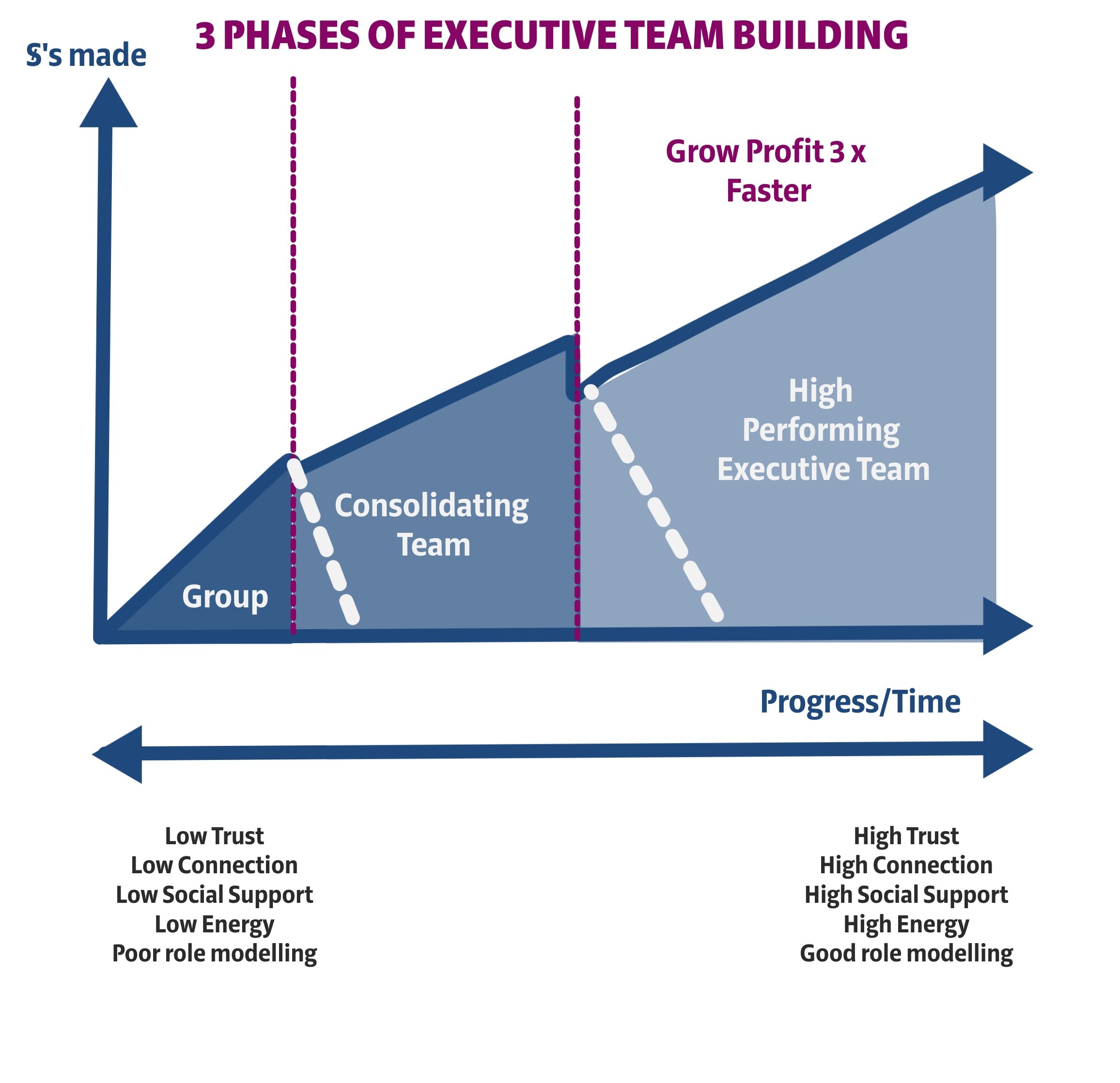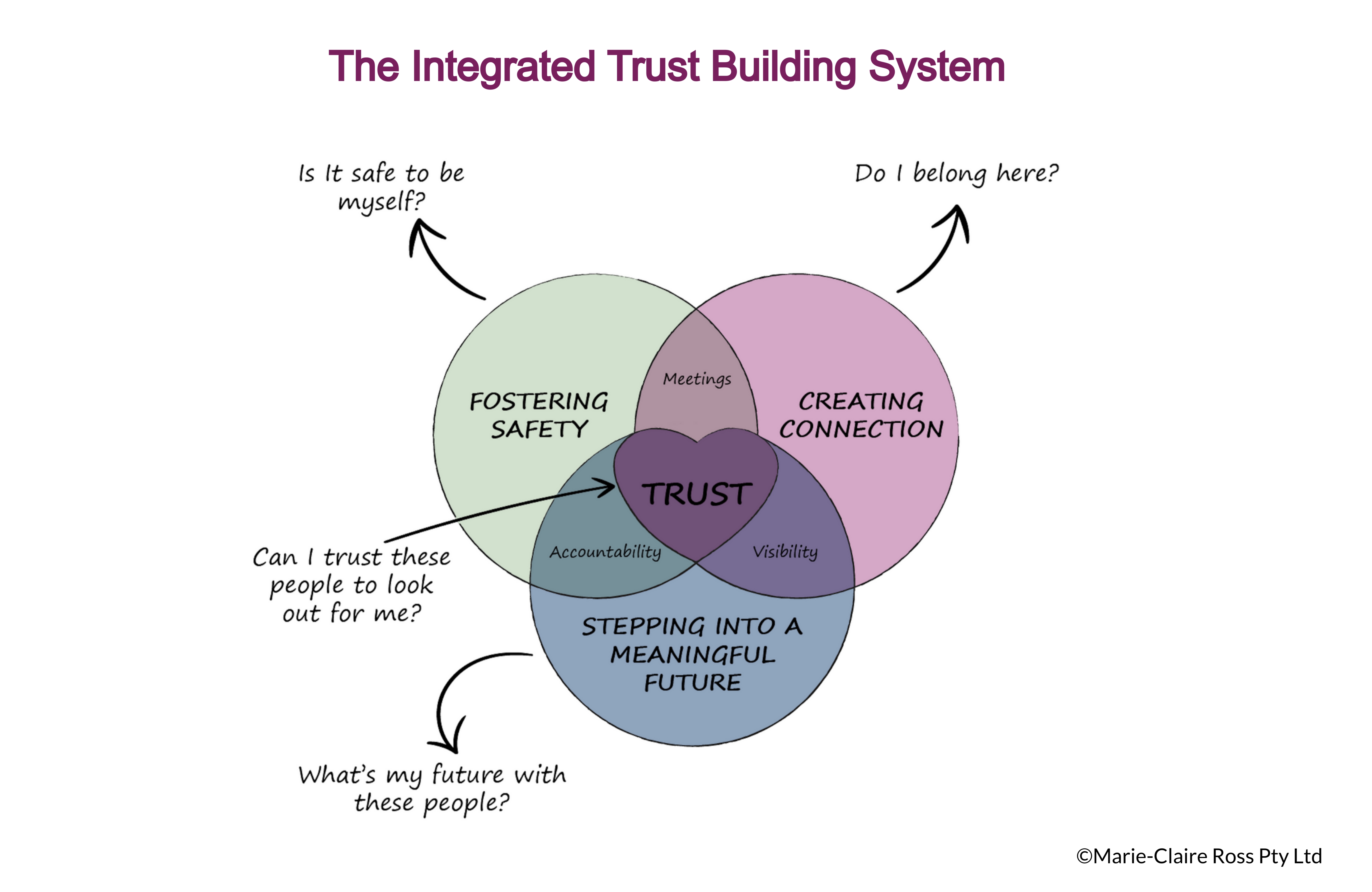
Everything is a product of evolution. Businesses go through cycles and need the right executives working at the right level for the business at that time. This comes...
There comes a time in every team, when the energy seems to dip.
It could be that people are worried about a new strategy, feel that things are static or that a highly respected team member has left.
No matter what the issue is - it's better to be aware of it early and do work on whatever it is that is making your team vibe seem a bit off.
This is where my Integrated Trust Building System comes in handy (from my book, Trusted to Thrive, get a free chapter here).
The model is based on three factors that neuroscience has found that our brains need to trust a situation. These being safety, creating connection and stepping into a meaningful future which catalyse to form trust. The beating heart of a high-performing team.

Every single moment our brains are scanning our environment and calculating whether we can trust the people around us. At work, we need to feel confident that speaking up or making a mistake isn’t going to be a career-limiting move. Our brain asks regularly – Am I safe to be myself? Do I belong to this team? Do we share a meaningful future together?
When these questions are answered affirmatively, it produces trust combined with psychological safety enabling us to operate at a more sophisticated level.
According to a 2023 McKinsey study, trust is now considered one of the strongest predictors of team resilience and performance during volatile times.
Trust acts like a shock absorber that is able to buffer the team against external (and internal) chaos. In fact, during uncertainty, teams with high trust and psychological safety outperform other teams by up to 27% on productivity and engagement metrics.
At its core, this requires a leader who is skilled at building trust in an authentic manner. Not just through communication, but through subtle and consistent belonging cues and actions. In other words, a leader who has honest conversations, drives accountability and is approachable.
The more people trust their leader, and each other, the more they will take risks and adapt ensuring steady progress of the organisation.
Workplaces require leaders who reassure people that their emotional needs are being met through both verbal and nonverbal communication. You can't use a one-size-fits-all approach. Instead, you want to make sure you cover all three communication practices using the various interactions below.
You will have some members who have a high need for safety. These are employees who find it hard to change, who need a lot of emotional support and who are worried about how others will perceive them.
What to do: Ensure you develop a consistent meeting and one-to-one routine to help people perform and work together optimally. Structure helps anxious people to feel safe because they know what to expect. In one-on-one meetings this requires asking questions and checking in with people, in order to gather information and address their concerns. In meetings, allow time for connection (each person gets to talk) and enable employees to feel safe expressing their emotions. Exploring the emotional landscape enables you to surface what's normally left unsaid, warning signs that get overlooked and allows for intuitive contributions (once people let go of their defensiveness).
Ensure people feel like they belong. A sense of belonging is crucial to our wellbeing and increases people's ability to succeed in their role. When people feel that they have friends in the team, they are more likely to be engaged in their work and stay.
Furthermore, help people to understand how their work connects to the team or organisational purpose. When people understand the meaning of their work and how it benefits others, they are more likely to be engaged in their work. They understand that their work matters.
What to do: Have regular social catch ups to help people feel connected to one another. If your team is hybrid, ensure you have regular face-to-face catch ups - off-sites are great.(quarterly is ideal). Provide regular recognition to each employee. When people feel valued for their contribution, it reduces self doubt and fear. Ensure praise includes how the work helped others (customers, you, the team, etc).
When we don’t know what’s going to happen next we will push back from committing to goals. The way to avoid this is for the leader to involve people in a meaningful future. It pulls employees into engagement and out of the low performance zone in the brain.
To do so requires more than providing detailed plans and forecasts.
Modern leaders must inspire through vision, build emotional connection, and simplify complexity into meaningful narratives. It's no longer just about strategy—it’s about imagination to enable each employee to envision themselves in a positive future for the organisation. It's not enough to talk about the future on its own. People need to see progress - ensure you have strong accountability standards in your team that are visible to all.
What to do: Effective leaders reframe problems by focusing the team on finding solutions. They see each problem as an opportunity for growth and hidden possibilities. Rather than lament "What are we going to do?", they ask "How can we rise to meet this moment?” Align people to an exciting future. Show people a clear path forward for both themselves and the organisation itself. If you don't know the path yet, paint the picture of what the future could look like and that together you'll work out how to get there. Make people accountable.
Recovering from a difficult event, takes time and patience.
Managing a team effectively requires working individually with your team members and the team together. Understanding what each team member requires is key.
Some individuals require a greater sense of safety, which means spending more time with them to provide a space for emotional expression. Others need more connection, involving more interaction with the team or understanding how their work contributes to success for all. Meanwhile, some people need to envision and feel a dynamic future they can engage with. Continue discussing the strategy and how it will manifest. Assist them in understanding what their future role will entail, including the skills they will need or potential promotional opportunities.
When teams get knocked around, it's not the time to panic. People are looking to you to make sure everything will be alright. While you can't guarantee any certainty, all you can do is show everyone you believe in them, the team, the company and a bright future. Use these techniques to bring everyone else along with you.


Everything is a product of evolution. Businesses go through cycles and need the right executives working at the right level for the business at that time. This comes...
-1.jpg)
If we want to lead our teams into the achievement zone, we need to lead ourselves there first.